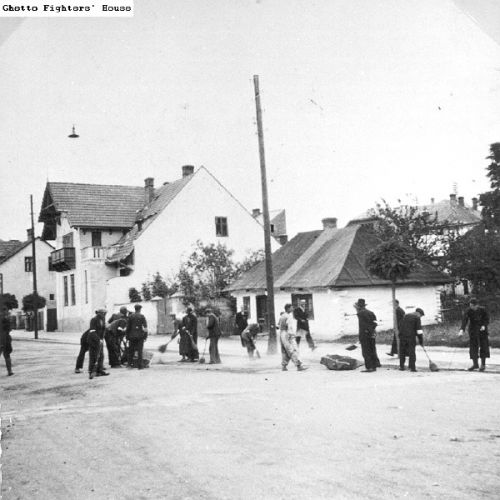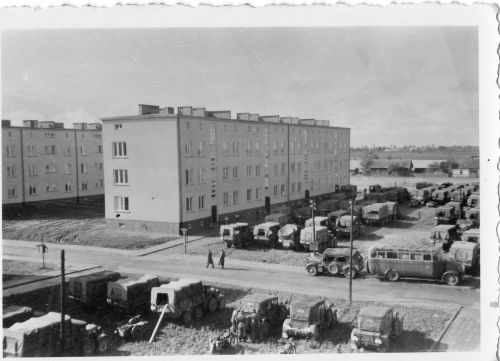Mielec

Mielec - Jews working as Forced Labourers (Ghetto Fighters House)
When the Second World War broke out in September 1939, approximately 3,500 Jews lived in Mielec, representing nearly half the town's population.They earned their living from commerce and artisanship, mostly in the garment, food and construction industries.A few were members of the liberal professions and assistance could be obtained from trade unions of Jewish merchants and artisans, a free -loan society and a Jewish bank, as well as Jewish welfare and mutual -aid organisations, including an orphanage.
Educational institutions included a Jewish school founded by Baron Hirsch, a Yesod Hatorah Heder, a Beit Yaakov school for girls, sponsored by Agudath Israel and a supplementary Tarbut school, where Hebrew was taught. Mielec also boasted a Jewish Library and reading room, Zionist and Youth movements, and a Akiva pioneer training facility. In addition a chapter of Agudath Israel and its Youth Movement were active in the town, as was a chapter of the Maccabi Sports and Culture organisation, which had a sports stadium. Art and drama flourished in the community, as did an orchestra for some time.
When the Second World War erupted, hundreds of Jews fled from the town to the east. On September 8, 1939, the Germans occupied Mielec and immediately began to seize Jews for forced labour. Approximately twenty young Jews who arrived in Mielec as refugees from Zabno, Dabrowa Tarnowska, and Tarnow were murdered on September 10 -11, 1939, in the nearby village of Bardechow. A couple of days later on September 13, the Germans seized mainly Jews with beards, placed them in the synagogue and the mikveh, set fire to the buildings and shot anyone who attempted to escape, over 150 Jews were murdered.
During 1940, abductions for forced labour became more frequent, both in Mielec itself and in the surrounding areas. In early 1940, a Jewish Council (Judenrat) was established, headed by an attorney named Fink. The Judenrat was ordered to pay periodic ransoms, conduct censuses of the Jewish population, and supply forced labourers on a daily basis. In the Spring of 1940, groups of young Jews fled across the River San to the Soviet zone. During late 1940, and early 1941, Jewish refugees from nearby locations and Krakow arrived in Mielec.

Mielec Kaserne - (Chris Webb Private Archive)
In 1941, the Jews of Mielec were concentrated in a special quarter in the town, under German supervision. In late 1941, and early 1942, the Germans began to seize Jews for forced labour in the Pustkow Labour Camp. On March 9, 1942, SS and German Police forces entered the Jewish quarter. They shot their way into homes, and ordered Jews to gather in the town's square. Approximately twenty elderly and unwell Jews were murdered as they made their way to the square.
Following a selection, approximately 750 Jews were sent to the labour camp in Pustkow. The 4,000 Jews who remained were led on foot to the airfield in Bardechow. Those too weak for the march were shot en-route. The others were held for four days. Another selection was conducted, and approximately 500 people, mainly elderly, the ill, women and children were murdered in a nearby forest. Yet another group of young Jews were taken to the Pustkow camp. The remaining group, which numbered approximately 3,000 Jews were sent to various locations in the Lublin area, such as Parczew, Wlodawa, Miedzyrzec Podlaski, Dubienka, where they shared the fate of the local Jewish inhabitants.
Source
The Yad Vashem - Encyclopedia of the Ghetto's During the Holocaust. Volume 1 Yad Vashen Archives, Jerusalem 2009
Photographs: Ghetto Fighters House, Chris Webb Private Archive
© Holocaust Historical Society, March 18, 2022

